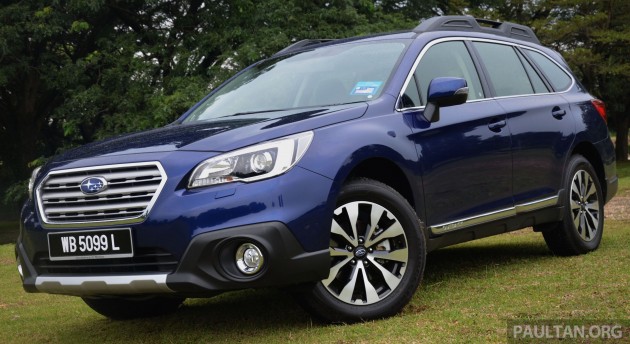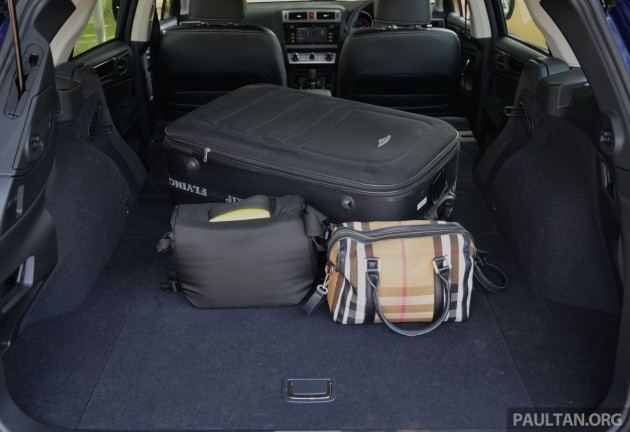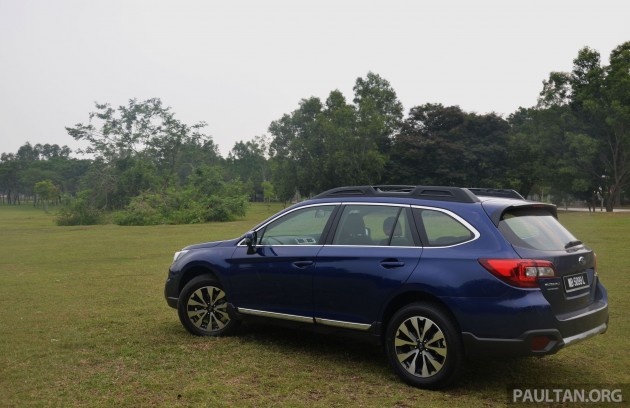
To start at the beginning, the Subaru Outback looked a lot bigger in the flesh than it did in pictures when yours truly first clapped eyes on it. Dimensions get recorded at 4,815 mm lengthwise while width is measured at 1,840 mm, overall height with roof rails, 1,675 mm – wheelbase is marked at 2,745 mm. With that said, its height leaves the Outback in a sort of no man’s land between a full-sized SUV and sedan-tall wagon.

Silver-accented front, side and rear underguards coupled to all-round black body cladding further reinforce its moderate off-road capabilities. A chunky front fascia, with Active Grille Shutter, gets framed by a pair of auto LED headlamps with self-levelling capabilities while the new shape is touted to be 11% more aerodynamic than its predecessor. Said Active Grille Shutter system opens up slats to enable more air to be drawn in.
On the 2.5i-S model, the Outback is equipped with 18-inch aluminium alloy wheels wrapped in 225/60 Bridgestone Dueler H/P Sport tyres – behind said wheels, ventilated discs are to be found. Suspension wise, MacPherson struts are featured in front while the rears are of the double wishbone variety. Further back, a tailgate spoiler is the only visual token given when it comes to any form of sporting cues.
The Subaru Outback we have here gets motivated by an atmospheric 2.5 litre horizontally-opposed four-cylinder petrol engine with 175 PS at 5,800 rpm and 235 Nm of torque at 4,000 rpm – said mill is mated to a six-step Lineartronic CVT gearbox. In true Subaru fashion, power gets put to the road via its Symmetrical AWD system with Active Torque Split system that is capable of sending up to 40% of power to the rear axle.
As for straight line performance, the 0-100 km/h sprint gets dispatched in 10.2 seconds while top speed is rated at 198 km/h. Fuel consumption is recorded at 13 km/l, CO2 emissions at 177 g/km on the combined cycle. Off-road performance gets augmented via the Outback’s X-Mode system, which manipulates the engine, transmission and brakes to help drivers navigate through less than perfect conditions.
With X-Mode engaged, Hill Descent Control is utilised by default to further help drivers maintain a set speed downhill. The Subaru Outback’s off-road abilities are further supplemented via the inclusion of an aluminium engine guard and a minimum ground clearance of 213 mm – the latter should come in handy for those pesky stream crossings encountered on the way to one’s favourite campsite.
On the inside, everything gets laid out in typical Subaru fashion – that is to say a dash fascia that would not look out of place on a Japanese budget car made in the early 2000s. Depending on where you stand, the interior can either be viewed as a deal-breaker or a saving grace for those who prefer to just jump in and spend a few minutes to get familiar with how everything works – it’s a foolproof layout, no doubt about it.
Plastics employed are hard as they should be to withstand the impending amount of abuse. Everywhere else, things remain pretty drab with multiple shades of grey and black adorning the interior, offset by hints of silver and faux carbon that run along the air-con vents, climate control units, steering wheel spokes and door cards. The front seats are electronically-adjustable eight-way units – the driver’s side with lumbar support.

Nothing wrong with said pews per se, adequate support was provided everywhere save for the under-thigh category, but the leather-trimmed seats were presented with a beehive-esque pattern that might nudge you in all the wrong places should one decide to don a thinner-than-usual T-shirt. Several feel-good gimmicks were to be found in the form of illuminated door pockets and variable colours scheme for the instrument clusters.
So far so good, then. That is until you jump in, thumb the starter button (with keyless entry) and take off. Call me weird but the first thing that became apparent was the lack of an automatic door lock function – c’mon guys. This is a car that costs RM224,846, was made in Japan and you couldn’t equip with auto door locks? Locking it manually resulted in a cheap-sounding, loud scher-clack that echoed throughout the cabin.
Not exactly a good first impression, then – a case made worse when I had to wind the windows down. Look, this may seem trivial but if I had spent well over RM220k, I would have expected my car to possess auto up-down capabilities on all four windows. Instead, only the driver’s window (with pinch protection) was fully automated on both ends of its travel. Again, that’s RM224,846 of your well-earned money.
On the upside, soft-touch materials were applied over portions of the dashboard and instrument cowl while vital contact points were coated in leather. Ignorant passengers will be marked out by the audible seatbelt warnings, as well. On the go, the electrically-assisted steering felt reasonably hefty (with tilt and telescopic adjustment) although one should leave the paddle shifters alone as action felt overly brittle and low-rent.
A short jaunt away from tarmac revealed that the Outback does indeed possess adequate performance to make it across the kind of terrain few owners will ever encounter – as mentioned, it’s not a full-fat off-roader so don’t go blaming me if you find yourself stranded out in the jungles of Borneo. Headed towards the intended photography site, the Outback was faced with several rocky dips and uneven surfaces.
In said situation, the aforementioned X-Mode system was called to perform – and perform with a degree of noise it did. Not that anything was wrong with it, though. The faint, clicking mechanical noise emitted during one of the many downhill descents served as a reminder that said system was at work. Also, one particular deeper-than-usual trench was dispatched with relative ease because of said elevated ground clearance.
Back on the highway, performance was less admirable. For starters, refinement was not up to par as tyre roar became apparent above triple digits while the surprising amount of wind noise had me constantly tugging on the controls just to make sure that all four windows were completely sealed – turning up the volume on the 12-speaker Harman/Kardonsound system would drown it out but then that’d be considered cheating.
Plus points included commendable levels of roadholding while the ride itself leaned towards the firmer side of things – still pliant enough for most drivers to keep it on the road for hours on end. All in all, the Outback would make a pleasant cruiser if not for the aforementioned issue of excess wind and tyre noise.
The presence of cruise control should also take the load off those long-distance trips. One pulse-raising gripe with said system though, was its rate of response – several moments had me jumping on the brakes last minute as toggling the buttons (many times) did not result in the right amount of retardation. Bury the throttle to overtake and you’d be rewarded with a surprisingly gruff engine note that leans on the good side of things.
For a more spirited drive, one only has to engage ‘Sport’ mode on the SI-Drive system, activated with the push of a button on the right spoke of the steering wheel. With the instrument cluster now basked in a rather crass-looking orange-red hue (‘Intelligent’ mode provides a more tasteful blue shade), the most noticeable difference would be a slightly improved throttle response – overall performance is still far from exciting.
Main culprit for said conclusion? The Lineartronic CVT gearbox. When push came to shove, said transmission caved in under pressure and whined for the entire duration it was asked to work hard. The familiar elastic sensation was also present in bucketloads, sad to say. Planted in an urban environment, the CVT fared no better as the majority of take-offs consisted of uncultured jerks.
Several points were added to its city-dwelling capabilities though, as parking the Outback took significantly less time than it would in competitors of the same stature – commendable all-round visibility and a wide-angle reverse camera certainly contributed to that. Unfortunately, said plus points will be deducted when you try to leave in a hurry as the electronic parking brake has a tendency to take its own sweet time in disengaging.
Aside from the drive, the Outback scored well in terms of interior space as a plethora of storage compartments were littered throughout the cabin along with two 12-volt outlets – one situated next to the USB and AUX slots while the other is hidden inside a cavity beneath the centre armrest. A two-tiered layout provides a platform for owners to store coins, cards and whatnot.
Elsewhere, more points get added in the Outback’s favour as both head and legroom were exemplary – a total of four individuals, the shortest being around 172 cm, managed to fit inside in total comfort. Also, Isofix anchors are featured on the reclinable rear seats while an electronically-operated sunroof (785 mm by 345 mm) with tilt-up function is standard on the Subaru Outback 2.5i-S.
As for practicality, prospective owners with an active lifestyle will be pleased to know that the cargo capacity stands at a vast VDA-measured 1,801 litres. In addition to that, a 60:40 split-folding function should come in handy for those trips to Ikea. Precious equipment gets shielded from prying eyes via a retractable (and detachable) cargo cover. Also, access to the boot is made easier with the standard-fit powered tailgate.

With its price tag still at the forefront of matters, kit count was slightly disappointing to say the least. A seven-inch touchscreen infotainment system with Bluetooth, AUX and USB/iPod connectivity did little to make things better. Don’t get me wrong, the system worked flawlessly, but much like the car’s character, the display lacked that final bit of zing to justify its presence in a car that costs this much.
Its interface was easy to work with while call quality over its Bluetooth connection clear enough. The Voice Recognition system, however, wasn’t as friendly to commands it was issued – a case made worse by my questionable enunciation, perhaps. Another omission that irked me greatly was the navigation system – how can you charge upwards of RM200k and not provide customers with navigation?
No such complaints on the safety front, though. The Subaru Outback 2.5i-S is equipped with a total of seven airbags, Vehicle Dynamics Control System (VDCS), ABS with EBD (electronic brake force distribution), hill start assist and Hill Descent Control along with a collapsible engine and gearbox measure to prevent said parts entering into the cabin during a collision. A five-star Euro NCAP rating is well and truly deserved, then.

So, after all is said and done, is the 2015 Subaru Outback 2.5i-S really worth its RM224,846 price tag? I’m afraid not – and that’s a shame, really. It has its flaws here and there but driven the way that it should be, it is a capable performer and decent runabout vehicle. Unfortunately, its asking price in Malaysia has placed it within a very premium segment – one where a Subaru badge just won’t cut it.
Furthermore, the existence of the Forester 2.0 XT and Forester 2.0i-L pretty much nullifies the need for an Outback. Why pay more when you can get behind the wheel of a higher-riding, equally capable, larger SUV with the same badge and more power – the latter is the case with the 2.0 XT. As for this writer, he’s already grovelling for a different Subaru.
- Sumber: paultan.org



No comments:
Post a Comment